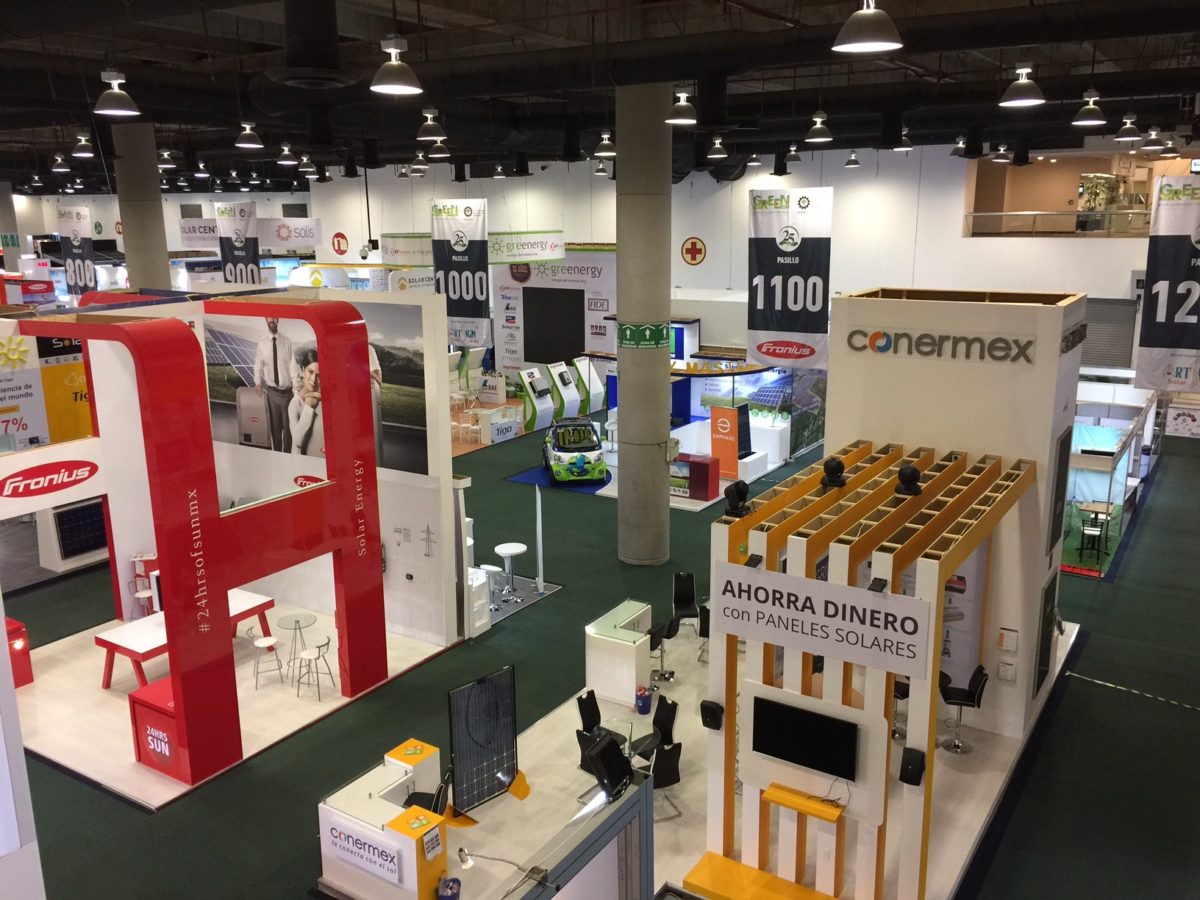Even though Green Expo covers a range of clean energy technologies, solar PV is at the center of this year’s exhibition with a wide range of module and inverter manufacturers displaying their latest products, as well as local Mexican distributors bringing many of these products to the Mexican large-scale, DG and off-grid markets.
Large-scale PV dominates the Mexican landscape with two auctions so far yielding very competitive bids for PV power plants in Mexico. Even though these auctions were open to a variety of power generation technologies, solar PV surprised observers by capturing about seventy percent of the auctioned capacity. Many of these plants in the first and second auction rounds will be built next year, catapulting Mexico from a sub one hundred MW market annually to a market with over 1 GW of annual installations. A third round is scheduled for this coming November and as many as eighty companies are expected to be in the race to participate.
One of these large-scale projects is the largest PV power plant in the Americas and consists of a 754 MW solar farm in Villanueva in the Mexican state of Coahuila. Italian power provider Enel secured this project as part of the 1 GW it was awarded in Mexico’s first renewable energy auction, which was held in 2016. In that auction Enel had bid a very low USD 35.5 per MWh (plus 20-year clean energy certificates), putting Mexico in the list of countries with the lowest solar LCOE.
Mexico’s historic energy reform is also helping the solar PV market grow. According to John von Frantzius, founder and CEO of Desmex, a panel manufacturer and PV developer based in Mexico, new energy laws and regulations now allow net billing, whereby a PV system owner is permitted to sell excess electricity generated by his system to off-takers keen on securing low-cost clean energy. Frantzius is also in the race to supply panels to Mexico City’s new airport, which is being designed by the renowned London-based architectural firm Foster + Partners.
While Mexico’s energy reform promises to boost Mexico’s residential and C & I solar markets, these markets are still very small compared to the utility-scale market. With the overall PV market predicted to skyrocket from just over 100 MW this year to well over 1 GW next year, the market for residential and C & I is expected to stay in the sub 100 MW range even next year. The lack of innovative and attractive financing and leasing models in these market segments is one key barrier limiting growth. In addition, Frantzius points out to pv magazine at Desmex’s booth at Green Expo, Mexico’s state-owned Comision Federal de Electricidad (CFE) has for so many decades controlled the supply of electricity to these customer groups, that it will take time for market participants to appreciate the opportunity provided by the reform of the country’s energy markets.
Given the small size of Mexico’s DG market, it comes as a surprise to see 22 string-inverter manufacturers touting their products on the Green Expo exhibition floor. But this is not an unusual phenomenon in a market that is just starting to unfold and as this market becomes more mature we can expect a winnowing out of many of these suppliers.
Quality will also play a pivotal role in establishing a strong presence in the Mexican PV market. At a breakfast event earlier today at the venue of the Green Expo, Hanwha Q-Cells signaled its strong entry into the Mexican market with an expanded portfolio of high-quality modules. Unlike other large module manufacturers, which source some of their cells from outside suppliers, Hanwha Q-Cells’ quality mantra dictates that all cells be sourced internally from three manufacturing hubs in South Korea, mainland China and Malaysia. Accordingly, production capacities for cells match those for modules at all three locations. Overall, the company boasts a cell and module production capacity of 6.8 GW.
Mexico’s energy auction this November will be closely watched by market observers inside and outside the country and we can expect a further drop in solar LCOE when the bidding details are revealed. Santiago Barcón, publisher of Mexican trade magazine Energía Hoy and an expert in Mexico’s energy markets, cautions that these low auction prices might prove unsustainable when projects enter the construction stage and encounter obstacles that might not be readily apparent under all the sunshine this large and populous country has to offer. Like ancient artifacts, which are scattered all over Mexico and can easily dent the business model underlying a low-priced solar bid. So there will be surprises in Mexico’s ramp-up to a gigawatt solar market, but we can be fairly certain that they will not stop this country from being a member of the GW club starting in 2018.
This content is protected by copyright and may not be reused. If you want to cooperate with us and would like to reuse some of our content, please contact: editors@pv-magazine.com.



By submitting this form you agree to pv magazine using your data for the purposes of publishing your comment.
Your personal data will only be disclosed or otherwise transmitted to third parties for the purposes of spam filtering or if this is necessary for technical maintenance of the website. Any other transfer to third parties will not take place unless this is justified on the basis of applicable data protection regulations or if pv magazine is legally obliged to do so.
You may revoke this consent at any time with effect for the future, in which case your personal data will be deleted immediately. Otherwise, your data will be deleted if pv magazine has processed your request or the purpose of data storage is fulfilled.
Further information on data privacy can be found in our Data Protection Policy.